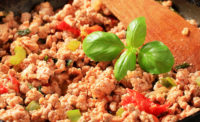A perennial favorite for summertime cookouts is fresh bratwurst. To produce fresh bratwurst that keeps customers coming back for more, you need to keep in mind several different things when you manufacture fresh bratwurst: meat used, nonmeat ingredients and manufacturing procedures.
While there are several different styles of bratwurst, we are going to discuss a fresh coarse-ground pork bratwurst stuffed into a natural hog casing or an edible collagen casing.
Selection of Meat
Fresh bratwurst should have a pleasing pink color. Always use raw materials that are fresh and in top condition. Myoglobin is the pigment that gives muscle its color. Both animal age and species affects the amount of myoglobin in muscle. Beef naturally has more pigment than pork which is the reason fresh retail beef cuts have a bright cherry color and fresh retail pork cuts have a pink color. The amount of myoglobin in an animal’s muscle is also influenced by an animal’s age. If you look at a sow carcass the muscles will have a darker pink color than muscles from a market hog. Sow carcasses make a very bright colored fresh pork sausage. The color of muscle is also influenced by the amount of activity the muscle receives when the animal is alive. Since a pig carries most of its weight on its front legs, muscles from the shoulder will have a darker color than muscles from the loin or belly. If you manufacture two batches of fresh bratwurst; one from loin and belly trimmings and one with muscles from the shoulder, even though they have an identical analytical fat content, the product manufactured from the pork shoulder meat will appear to be leaner than the product manufactured from the loin and belly trimmings.
Nonmeat Ingredients
Typical nonmeat ingredients used in fresh bratwurst include; water, salt, dextrose, spices, onion and celery. There are many commercial seasoning blends available to small and mid-sized meat processors for fresh bratwurst. During manufacture I like to add 3% water to help facilitate mixing. It will help assure good distribution of the dry nonmeat ingredients.
Manufacturing Procedures
When manufacturing fresh bratwurst you want good particle definition. Particle definition is the ability to see distinct particles of fat and lean in the finished product. Product with poor particle definition has a smeared appearance and often looks like it contains more fat than it actually does. Good particle definition is achieved by; grinding well-chilled meats (30-35˚F) and maintaining your grinding knife and plate in good condition. To maximize particle definition you can put your coarse ground meat/nonmeat mixture in the freezer for an hour before doing the final grind.
Mixing time is critical in the manufacture of fresh bratwurst. Mix just long enough to achieve good distribution of the fat and lean and nonmeat ingredients, typically about 2 minutes. Excessive mixing will result in over extraction of protein and chewiness in the cooked product. Two identical batches of fresh bratwurst, one mixed 2 minutes and one mixed 10 minutes, will eat very differently.
Following is a manufacturing procedure that works well for fresh bratwurst.
- Coarse grind meat (35˚F) through a 1/2 inch plate. Typical fat content is 30%.
- Transfer to mixer. Add water (ice water) and any nonmeat ingredients. Mix 2 minutes.
- Regrind through a 3/16 inch place with a bone collector.
- Stuff into 30-34 mm casings.
Remember: The Number 1 way to generate repeat sales is to have a consistent product.








